be quiet! Pure Power 11 FM 650W & 750W Overview
Coolers and cooling fans aside, be quiet! are also renowned for their power supplies with exceptional reliability, especially the Dark Power and Straight Power lineup. Earlier this year, be quiet! has introduced its new Pure Power 11 FM lineup that comes with a fully modular design to make cable management easier. For the test this time, we’ll be taking a quick look at two models from the series, the Pure Power 11FM 650W and 750W just to see how well can it handle some of the latest hardware we have in our arsenal.
Specifications
| Model | Pure Power 11 FM 650W | Pure Power 11 FM 750W |
| Continuous Power (W) | 650 | 750 |
| Peak Power (W) | 720 | 820 |
| Form Factor | Version 2.52 | Version 2.52 |
| Form Factor EPS 12V | Version 2.92 | Version 2.92 |
| Modular Cable Management | Yes | Yes |
| Topology | LLC + SR + DC/DC | LLC + SR + DC/DC |
| Wire-free Design (DC-side) | Yes | Yes |
| Voltage (Vac) | 100-240 | 100-240 |
| Frequency (Hz) | 50-60 | 50-60 |
| Input Current (A) | 10/5 | 10/5 |
| PFC | Active | Active |
| Power Factor at 100% Load | >0. |
>0.98 |
| Compliant to Intel C6/C7 | Yes | Yes |
| Standby Power Consumption (W) | <0.14 | <0.14 |
| Average Life Time (h/25°C) | 100,000 | 100,000 |
| Operating Temperature up to (°C) | 40 | 40 |
Unboxing
The packaging for the Pure Power 11 FM is really simple overall, both the Pure Power 11FM 650W and 750W look pretty much identical in terms of the package design, except for the rated power and minor difference in the +12V rails. bAs be quiet! didn’t include too much information on the box, you’ll have to visit the official product page if you need more technical information on the product.
The Pure Power 11 FM 650W
Starting off with the Pure Power 11 FM 650W, the accessories that come together inside the box include the pack of modular cables, a 3pin UK plug AC Power Cord With 13A Fuse, a pack of screws, and a user’s manual.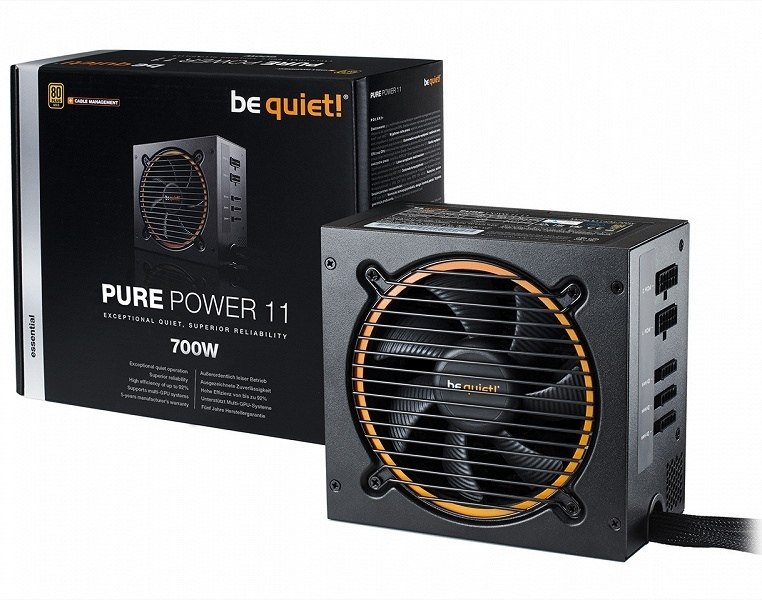 The modular cable pack includes all of the essential cables i.e 1 x 24-pin ATX cable, 2 x SATA power cables, 1 X SATA + 4-Pin Molex power cable, 2 x PCIe 6+2 Pin cable, 1 x 4+4 Pin EPS cable, and an unlabelled cable which is supposed to be the 4-pin EPS cable.
The modular cable pack includes all of the essential cables i.e 1 x 24-pin ATX cable, 2 x SATA power cables, 1 X SATA + 4-Pin Molex power cable, 2 x PCIe 6+2 Pin cable, 1 x 4+4 Pin EPS cable, and an unlabelled cable which is supposed to be the 4-pin EPS cable.
Nothing fancy about the cables but if I were to compare it to the Straight Power 10 600W we have from years ago, the all-black and flat modular cables are much more favorable when it comes to cable management because they’re mostly flexible and easier to bend to fit different angles.
For the Pure Power 11 FM 650W, although be quiet! never specifically specify the fan model used but it is according to them, a silence-optimized fan that will get the job done nevertheless. There’s nothing fancy about the design but it has pretty much everything you need for a decently built fully modular power supply.
The Pure Power 11 FM 750W
Moving on to the Pure Power 11 FM 750W, the accessories are pretty much the same as what you’ll get with the Pure Power 11 FM 650W – the 3pin UK power cord with 13A fuse, the modular cable pack, screws, and user’s manual.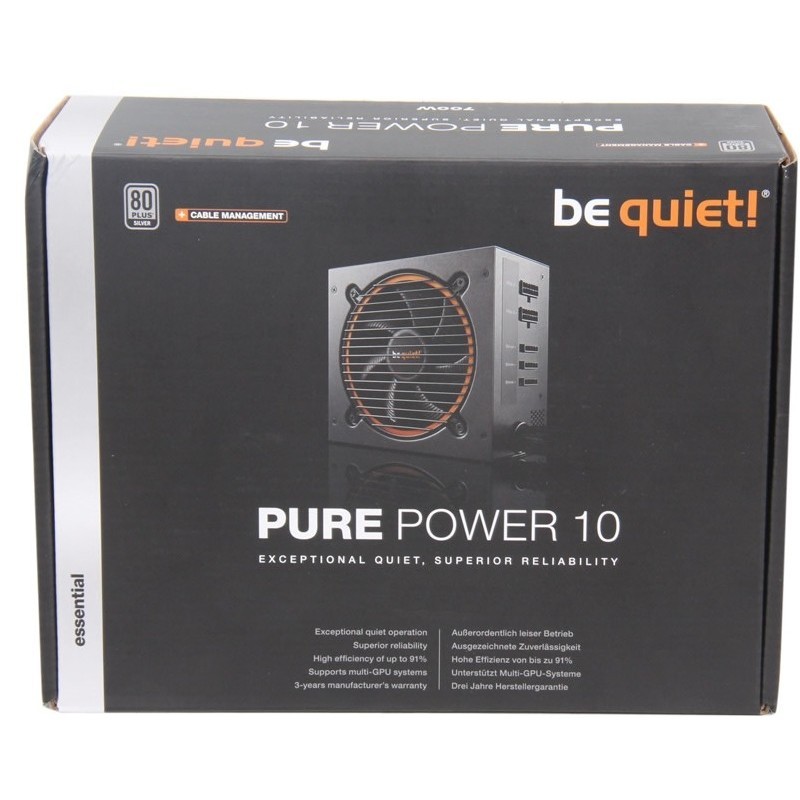
The only difference we notice is the extra 4+4-pin EPS power cable while taking a closer look at all the included cables, which makes it suitable for motherboards that require 2 x 4+4-Pin EPS power cables to operate.
Design-wise, the looks and build quality of the Pure Power 11 FM 750W is technically identical to the 650W model. If we don’t look at the power rating and the specs on the label sticker, it’s almost impossible to tell the difference between both 750W and 650W models from just the look.
User Experience
| CPU | Intel Core i9-10900K @5GHz |
| Motherboard | ASUS ROG Maximus XII Apex |
| Memory | Teamgroup T-Force Dark Z FPS DDR4-4000 |
| Graphics Card | NVIDIA GeForce RTX 3070 / NVIDIA GeForce RTX 3070 Ti |
| Power Supply | be quiet! Pure Power 11 FM 650W / be quiet! Pure Power 11 FM 750W |
| Primary Storage | Kingston KC2000 1TB NVMe SSD |
| Secondary Storage | WD Black 6TB |
| CPU Cooler | Cooler Master MasterLiquid ML360R |
| Chassis | Open Benchtable |
| Operating System | Windows 10 64bit |
For our synthetic benchmark tests, we will be doing the same set of tests using FurMark GPU stress test tool, ROG RealBench, Cinebench R23, Prime95 for 1 hour each for both the Pure Power 11 FM and the RTX 3070, RTX 3070 Ti respectively.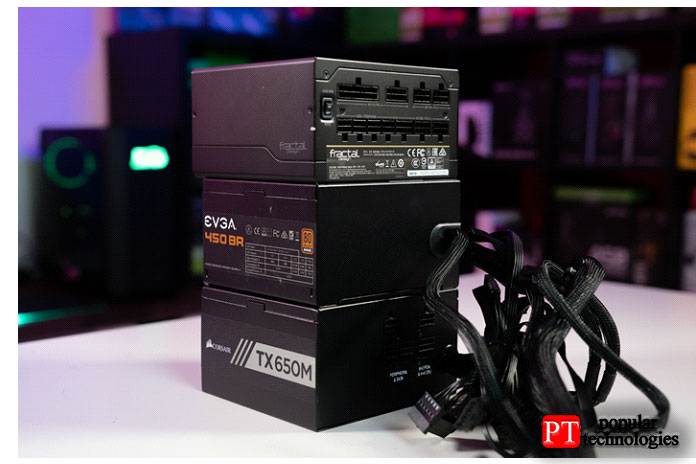 The total system power draw for each of the tests is recorded and listed in the following table:
The total system power draw for each of the tests is recorded and listed in the following table:
| FurkMark 1.27 | ROG Realbench 2.56 | Cyberpunk 2077 | |
| GeForce RTX 3070 | 384W | 416W | 395W |
| GeForce RTX 3070 Ti | 442W | 468W | 457W |
From the test, we can see the total system power draw seems to be within what both the Pure Power 11 FM 650W and 750W can handle.
On the RTX 3070 setup, both power supplies can handle all the benchmarks with ease and no signs of performance hiccups can be observed. Similar behavior can be seen on the RTX 3070 Ti setup, which the Pure Power 11 FM 650W handled quite well despite the fact that the RTX 3070 Ti requires a minimum 750W power supply if we refer to the official specifications from NVIDIA. However, we don’t recommend pushing your luck on this as some RTX 3070 Ti might have a higher power draw, depending on how the AIB partners configure it.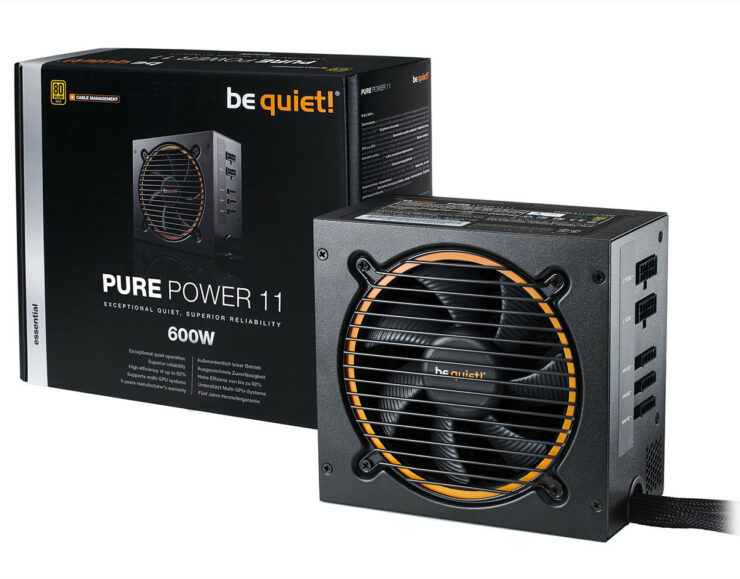
The average temperature during load for both the Pure Power 11 FM 650W and 750W is always around the average 48ºC±, so overheating is the last thing to worry about if you’re using it normally – that excludes abnormal use like cryptocurrency mining or unauthorized tampering the unit. Load temperature aside, the barely audible fan noise is favorable for those who want to minimize the noise from their system and this makes it a considerable choice for low noise builds.
Verdict
Performance-wise, both the be quiet! Pure Power 11 FM 650W and 750W did meet our expectations and are capable of handling the newer hardware that we have without any noticeable performance hiccups. Although 750W is the highest power rating the Pure Power 11 FM lineup has to offer, I believe it’ll suffice for most users or gamers nowadays? With the ongoing GPU shortage and insanely high price, you’re lucky enough if you can find a reasonably affordable RTX 3060, let alone an RTX 3070.
The build quality is decent and the fully modular design is something that I’d always appreciate, especially flat cables because of the convenience when it comes to cable management. Though I do have a small concern with the unlabelled cable that comes with the Pure Power 11 FM 650W, which can cause some inconvenience to users with less experience with the type of connectors on their power supplies.
Though I do have a small concern with the unlabelled cable that comes with the Pure Power 11 FM 650W, which can cause some inconvenience to users with less experience with the type of connectors on their power supplies.
As for the price, the be quiet! Pure Power 11 FM 650W and 750W retail at $99.99 and 114.99. Looking at how the Pure Power 11 FM 650W and 750W perform in our tests, I’d say that’s still a pretty fair price for the specs and what it is capable of, despite not having an insanely long warranty period like some of the competitors are offering.
be quiet! PURE POWER 11 FM Review (750W)
When choosing a power supply for a lot of budget to mid/high range PC builds (such as those in our monthly gaming pc builds) I will recommend anywhere from 500W to 750W in general. and that’s where the newer line of PSU’s in be quiet!’s line of Pure Power 11 series come into play.
Choosing a power supply is subjectively one of the more tedious parts when choosing a component for your brand new PC build while being probably one of the most important in terms of being able to keep your PC powered and ensuring it has enough juice to push it to its potential.
That’s why you want to choose a reputable power supply along with one that has all of the features you want at a reasonable cost. That’s because you want the assurance your PC will continue to have enough power while saving extra costs for high-performance hardware like your CPU or GPU.
This is exactly where be quiet! has placed their Pure Power 11 models gearing them towards a great price per performance spot in the market, while maintaining a good quality PSU.
Today I’m taking a look at the be quiet! Pure Power 11 FM 750W PSU model and giving it a once over to give you an idea as to whether this is the power supply for you or not.
Who is the be quiet! PURE POWER 11 FM 750W For?
In general, Pure Power 11 FM power supply should fit perfectly into a mid-higher end PC build given that it’s currently rated at 750W, which should easily support a higher-end Ryzen build with a higher-end graphics card such as up to an RTX 3080 (so quite versatile).
While I’m taking a look at the 750W model, this model also comes in 550W and 650W options in the fully modular version of the power supply, which makes it the perfect range of choice for most PC builds recommended here at Newb Computer Build.
At the moment of publishing, the 750W model is going for around $115 USD, which is priced perfectly given that it’s an affordable power supply that’s also fully modular (comes with no cables attached and you only need to use the exact cables needed). And in my opinion, one should always go for a power supply that’s fully modular when possible, or at the very least semi-modular.
With that being said, the Pure Power FM 11 750W model is currently priced very competitively with other 750W Gold Rated and fully modular power supplies at the moment, with only a handful that is at most $35 cheaper, and not reputable models I would necessarily recommend.
Each and every power supply in the Pure Power line of power supplies come with the be quiet! silence optimized 120MM fan, which is standard and a decently cool and quiet fan that’s similar to the other be quiet! silent fan products.
The Pure Power 11 FM is also an 80+ gold-rated power supply that is up to 93.9% efficiency, which is actually at the TOP of the gold rating standard for power supplies — so this power supply could also be considered an economical choice for those looking to squeeze a good amount of performance while spending a little less on their power supply upfront.
be quiet PURE POWER 11 FM 750W
be quiet! PURE POWER 11 FM 750W Specifications
Below you’ll see the complete technical specifications for the Puer Power 11 Fm 750W model. You can see that it does support up to 750 Watts of continuous power, with a peak power limit of 820 Watts. It is fully modular and supports a voltage range of 100-240. There is a fairly standard frequency range of 50-60Hz. There is active power factor correction (PFC), which enables a power factor at 100% load of >0.98 — which enables a high-efficiency standard for this power supply.
PSU efficiency is what actually sticks out to me and really speaks to be quiet!’s price per performance stance as it is very competitive, if not better than a lot of power supply with the same features in the Gold Rated standard category.
The average lifespan is rated at 100,000 hours at an average temperature of 25 degrees celsius, which is fairly standard for PUS models in this range.
I do find the operating temperature being only at 40 degrees celsius a bit interesting, as it is 10 degrees less than other competitive models, like the EVGA SuperNova, which is typically at about 50 degrees celsius. One could also argue that if you live in a hot climate and had your PC running, you could easily hit 40 degrees room temp or operating temp where your PSU is housed.
| Model | Pure Power 11 FM 750W |
| Continuous power (W) | 750 |
| Peak power (W) | 820 |
| Form factor | Version 2.52 |
| Form factor EPS 12V | Version 2.92 |
| Modular Cable management | ✓ |
| Topology | LLC + SR + DC/DC |
| Wire-free design (DC-side) | ✓ |
| Voltage (Vac) | 100 – 240 |
| Frequency (Hz) | 50 – 60 |
| Input current (A) | 10 / 5 |
| PFC | active |
| Power factor at 100% load | >0.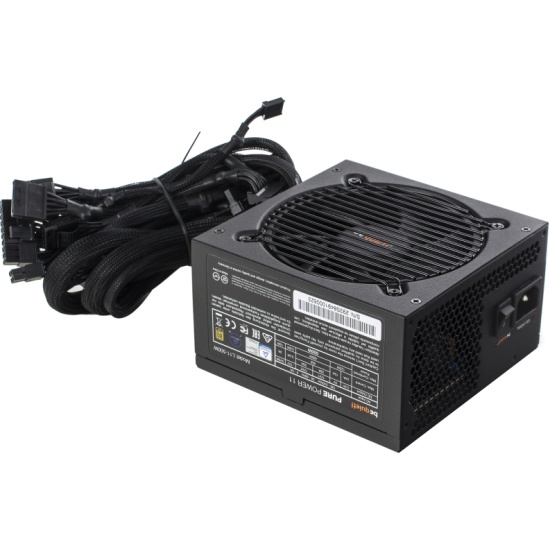 98 98 |
| Compliant to Intel C6/C7 | ✓ |
| Power consumption in standby (W) | <0.14 |
| Average life time (h / 25°C) | 100,000 |
| Operating temperature up to (°C) | 40 |
In terms of size, the Pure Power 11 FM measures 165mm x 150mm x 86mm (L x W x H), making it a decent size for an ATX standard PSU, however a bit longer than some of the competition (such as the EVGA SuperNova GA 750, which caps out at 150mm in length), however not a huge deal, but still shorter than the more premium Super Nova 750 G2 I currently had at 180mm in length.
Inputs on the enclosure of the be quiet PURE POWER 11 FM 750W
be quiet! PURE POWER 11 FM 750W: a look at the enclosure
Supported Ports and the input side of the PSU
As seen above, the included ports and cables are an ATX Motherboard (20+4 pin), 8-pin CPU, a 4-pin CPU, four PCIe (6+2-pin), nine SATA, two HDD and floppy.
Looking at the ports above, you can see that they are all relatively straightforward and as it’s modular a simple plug-and-play.
Each of the inputs is nicely laid out, but I was curious as to why the opening where the Drive input is, is a tad wider than the actual input. Perhaps the enclosure is also used for other models that make full use of the space. Not so much of a bad thing, but it did make me go ‘hmm’.
Top of the be quiet PURE POWER 11 FM 750W
Top Side of the PSU
On the top you of course have the include silenced optimized 120mm be quiet! fan. One of the things I like about be quiet! the most are their minimalistic design style, and this is most apparent when looking at this side of the enclosure. This is because it’s the most detailed in terms of design, but the only thing that really pops is the “quiet” part of the “be quiet!” logo in the centre of the fan itself.
Other than that, the fan is a smooth rippled plastic and the fan is covered with a simple, but eloquent black grate. The perfect amount of design for what this is, which is a power supply that gets stored typically at the bottom of your case, forever to be forgotten.
A glimpse at the two sides of the be quiet! Pure Power 11 FM Power Supply
The Sides of the PSU
On the one side of the PSU, we have the informational sticker outlining the power supplies details. On the other side, there is a simple embossed “be quiet!” in the metal itself. Again, a very minimalistic approach to design, which suites the PSU well.
Back of the enclosure of the be quiet PURE POWER 11 FM 750W
Backside of the PSU
On the back of the power supply is where you input your AC plug, and it’s turned on by a typical power switch. Right above the plug input is a very small be quiet! sticker logo, and right below the plug input is a voltage rating sticker outlining 100 – 240v ac.
And finally, the rest of the backside is simply a metal grate with a ton of hexagonal holes that are side by side, with the sole purpose of exhausting all of the air blown into the enclosure by the 120mm fan on top.
be quiet! Pure Power 11 FM 750W: What’s included
In the box for the Pure Power 11 FM, we have the PSU itself, which is simply wrapped in bubble wrap on the lefthand side of the box.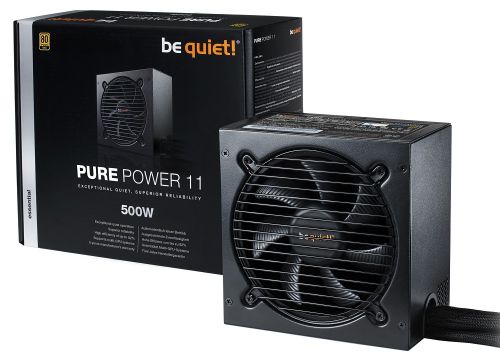 Then, right on top, there is the manual, which outlines how to get started and some other information about the power supply.
Then, right on top, there is the manual, which outlines how to get started and some other information about the power supply.
Then on the right-hand side of the box, underneath a cardboard top, included is a small bag of screws to secure the power supply to your pc case, and then a plastic-wrapped bag that includes all of the modular cables.
The modular cables included are an ATX Motherboard (20+4 pin), 8-pin CPU, a 4-pin+4-pin, two PCIe (6+2-pin) cables with a total of four 6+2pin inputs, and three SATA cords that include nine SATA, two HDD, a floppy and the AC power cord.
What’s Included Summary
Overall, what’s included is pretty standard for this range of power supply. be quiet! didn’t necessarily go over the top in terms of including anything extra, and sometimes modular PSUs do include a nice case of some sort to store unused cables in as one example. However, given that a typical user may have something like 3 unused cables max in this sort of setup that goes unused (unless you have a ton of SSDs or extra peripherals or 2 graphics cards, most likely you won’t use those three extra cables, two of the three SATA and 6+1 pin PCIe as examples), it’s not too hard to find a space to put those.
Finally, each of the cables is a flat black plastic cable, which looks nice enough. However, they are all sleeveless with the exception of the ATX Motherboard cord. This isn’t a big deal but may sway some who care about that sort of thing.
be quiet! PURE POWER 11 FM 750W in Action: How does it perform?
be quiet! PURE POWER 11 FM Fan Noise versus Load (Source: https://www.bequiet.com/)
How loud does it get?
I swapped my current EVGA SuperNova 750 G2 for the be quiet! PURE POWER 11FM to get a real feel for how it performs in terms of having everything a mid-high end PC build would need and whether it actually is as silent as they say.
If you look below you see that be quiet! has outlined the various loads the PSU would undertake and the given notice the fan / PSU outputs in db.
So technically, the fan doesn’t even have to try too much until it hits about 50% load and then the noise increases steadily as the load increases.
And when using the power supply, the fan spins so smoothly and steadily, that I couldn’t even subjectively hear it at all. So I must say, it actually is really quiet.
So I must say, it actually is really quiet.
be quiet! PURE POWER 11 FM 750W Power Supply in Action
Installation and thoughts on overall quality
I’m currently using a budget Corsair 175R case, which is a mid-tower and theoretically should fit most ATX PSUs with ease. However, it is a bit cramped on the bottom where the PSU goes, especially when you first get it as an HDD cage occupies the bottom as well. I say this as the previous PSU I was using (the EVGA SuperNova), is actually a bit longer, and with thicker cables with sleeves, and it was a very tight squeeze to get it to initially fit (I also had to take out the initial HDD cage in order to do so).
With that being said, the be quiet! PURE POWER 11Fm 750W actually fit quite easily being some mm shorter and having mostly sleeveless flat black cording that maneuvered easily.
So while some may see sleeveless cords as being a bad thing, it may actually benefit smaller mid-tower cases (or micro atx cases if you’re going that route).
The one thing that bothered me a bit about the cords as well as the SATA cords and the way they are ribboned (if that’s the right word). I have my SATA SSD’s installed vertically at the very back of the case, and when plugging them in with the included SATA cord, it doesn’t install so that it sits flat and rather protrudes a bit outwards. This is a minor inconvenience as I need to slide my back cover on and may need to pay special attention when doing so now. This, however, would only be for those who have their SSDs installed in a similar manner.
Now in terms of how it operates — once all connected, set up and running, the PURE POWER 11FM performs smoothly. Upon startup and with minimal load, the fan sounds virtually silent, and it fits fantastically in my mid-sized case as an ATX PSU that’s just above ATX spec in terms of length at 165mm.
be quiet! Pure Power 11 FM 750W: Is it worth the purchase?
Why you should get the Pure Power 11 FM:
- Great price per performance and quality
- Fantastic top end 80+ Gold Rated cert power supply efficiency of up to 93.
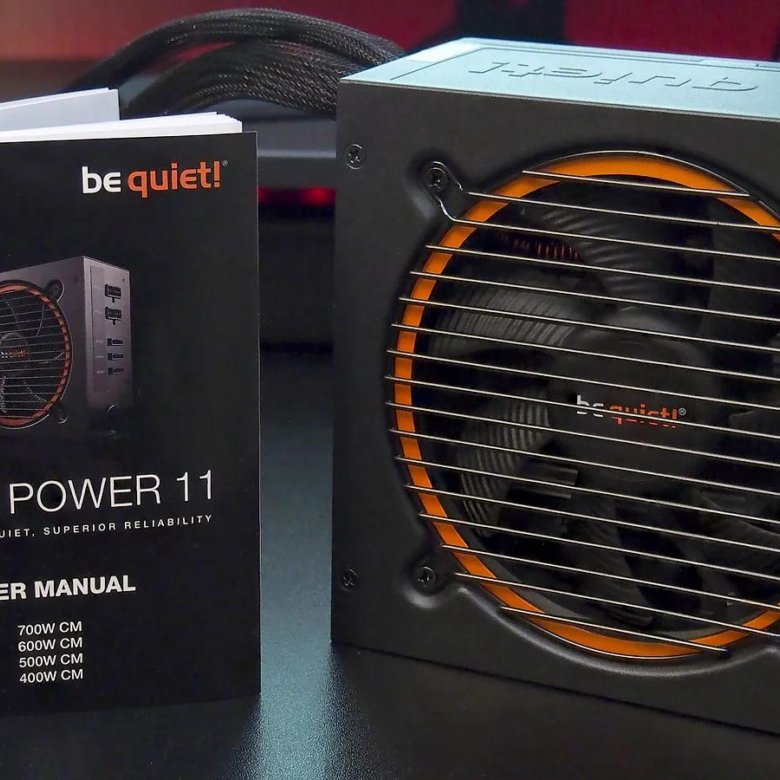 9% efficiency
9% efficiency - Looking for a power supply that’s fully modular and relatively quiet with the silenced-optmized 120mm be quiet! fan
What could be improved on the Pure Power 11 FM:
- Low manufacturer warranty than most at 5 years Warranty
- All modular cables could benefit from sleeves (with the exception of the 24 pin ATX cord)
- Relatively low operating temperature rating at only 40 dgerees celcius
The improvements for the be quiet! Pure Power 11FM 750 W PSU comes from perhaps needing a higher maximum operating temperature, while also having a relatively low manufacturer’s warranty at only 5 years. While 5 years is decent, other competitors in this category typically have around 7-10 years on their warranty.
The final improvement could be the addition of sleeves to all of the cables, as the 24 pin connector is the only one. While I personally don’t care too much and welcome sleeveless cable for fitting into smaller budget pc cases, others may find the lack of sleeves displeasing.
All in all, this is a great power supply that definitely has a great cost per performance stance as be quiet!’s intention is. This power supply delivers an impressive high-end 80+ Gold cert efficiency and has all the features most gamers want in a power supply, while also being relatively affordable.
Xiaomi Mi 11 naked in tests: it’s not always the best
In the meantime, we look forward to the launch of the global variant, Xiaomi Mi 11 it is in the hands of the first Asian buyers, and soon they put it to the test in benchmark test . Xiaomi’s new top of the range is the world’s first power demo Snapdragon 888 , but not only.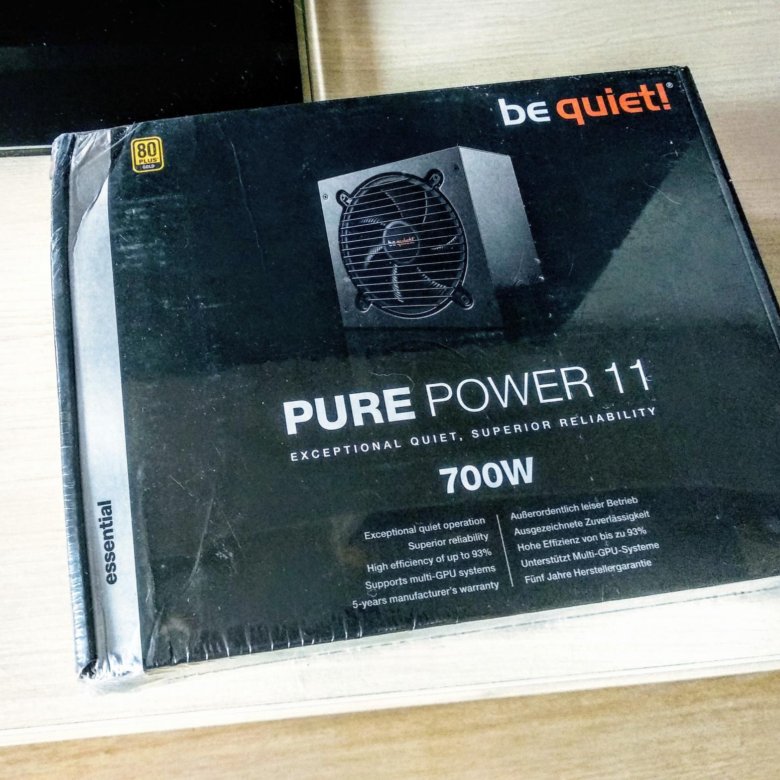 We opted for an even more advanced screen this round, thanks to the battery compartment that made some people turn up their noses. That’s why we were curious to see the first tests carried out on a smartphone, not only in terms of pure power.
We opted for an even more advanced screen this round, thanks to the battery compartment that made some people turn up their noses. That’s why we were curious to see the first tests carried out on a smartphone, not only in terms of pure power.
READ ALSO :
Xiaomi.eu: here are the models updated to Android 11 Stable | Download
content
performance
As expected, Xiaomi Mi 11 was the first to be moved Snapdragon 888 . In addition to the 5nm manufacturing process, instead of 7nm has an improved Kryo 680 processor is formed as follows: 1 x 2.84 GHz Cortex-X1 + 3 x 2.42 GHz Cortex-A78 + 4 x 1. 8 GHz Cortex -A55. In addition, Adreno GPU 660 guarantees a performance increase of 35% minus more moderate consumption. Strong memory from 128 / 256GB UFS 3.1 storage (non-expandable) ed 8 / 12GB LPDDR5 RAM at 6.400Mbps, Xiaomi Mi 11 can excel in AnTuTu tests. Received about 722.000 points from poco is lower than the potential promised by Qualcomm. But you know, Xiaomi smartphones are like diesels and performance should also increase with future updates.
8 GHz Cortex -A55. In addition, Adreno GPU 660 guarantees a performance increase of 35% minus more moderate consumption. Strong memory from 128 / 256GB UFS 3.1 storage (non-expandable) ed 8 / 12GB LPDDR5 RAM at 6.400Mbps, Xiaomi Mi 11 can excel in AnTuTu tests. Received about 722.000 points from poco is lower than the potential promised by Qualcomm. But you know, Xiaomi smartphones are like diesels and performance should also increase with future updates.
Looking at the overall ranking, Xiaomi Mi 11 thus manages to outperform all competitors currently available on the market. But the situation will change if we focus solely on measuring CPU and GPU. Using the stress tests provided by 3DMark , here’s the Mi 11 dropping to third position, leaving room for Huawei Mate 40 Pro e Mate 40 . Credit is everything Kirin 9000 , HiSilicon and TSMC’s latest high-end bastion. Compared to Snap 888, this chip boasts a more advanced processor (1 x 3.13 GHz + 3 x 2.54 GHz + 4 x 2.05 GHz).
Compared to Snap 888, this chip boasts a more advanced processor (1 x 3.13 GHz + 3 x 2.54 GHz + 4 x 2.05 GHz).
3DMark
Games
This performance is a parameter that has allowed the world of smartphone games to grow rapidly. At the same time, such power in such a tiny device is fraught with thermal throttling. Fortunately, this is not the case for Xiaomi Mi 11, which is able to keep the temperature down. Test using PUBG , the smartphone stops at one average temperature of 44 ° C , although the difference with the rest of the rating is several degrees higher. It should be noted that the Mi 10 and Mi 10 Pro turned out better, although we are talking about only one degree less.
Temperature
Speaking of frame rate , tests done on Xiaomi Mi 11 show how it can support 59.5 fps on average , with a range of just 0.5 fps.
FPS
Freedom
With the exception of the more powerful but less power hungry Snapdragon 888, there are those who doubt the actual battery consumption of the Xiaomi Mi 11. In addition to the fact that the device is smaller than the Mi 10 ( 4.600 mAh vs 4.780 mAh), display Quad HD+ at 120Hz (instead of 90Hz) promises to be very power hungry. And in fact, the result is predictable: according to preliminary tests, Mi 11 behaves worse than many smartphones. Among them are also Xiaomi Mi 10 Ultra with a 120 Hz display but Full HD +, as well as, obviously, Mi 10 and Mi 10 Pro. However, nothing prevents you from setting the screen of Mi 11 to Full HD + and returning to more discreet levels of autonomy. However, there are other models that perform worse despite being in Full HD+ rather than 120Hz, such as some Samsung and Red Magic flagships.
In addition to the fact that the device is smaller than the Mi 10 ( 4.600 mAh vs 4.780 mAh), display Quad HD+ at 120Hz (instead of 90Hz) promises to be very power hungry. And in fact, the result is predictable: according to preliminary tests, Mi 11 behaves worse than many smartphones. Among them are also Xiaomi Mi 10 Ultra with a 120 Hz display but Full HD +, as well as, obviously, Mi 10 and Mi 10 Pro. However, nothing prevents you from setting the screen of Mi 11 to Full HD + and returning to more discreet levels of autonomy. However, there are other models that perform worse despite being in Full HD+ rather than 120Hz, such as some Samsung and Red Magic flagships.
Freedom
refill
Well, the battery life of Xiaomi Mi 11 is not one of the best in the sector, but how does it behave during the charging phase. Yes, because the smartphone guarantees support for Mi Charge from 55W , as well as the new GaN charger. Apart from the controversy about its sold separately, it allows you to charge Mi 11 in about 52 minutes waiting for , the result is not a record, but still significant. of course AICU 5 PRO e Xiaomi Mi 10 Ultra still have the lead thanks to the 120W ultra-fast charging.
of course AICU 5 PRO e Xiaomi Mi 10 Ultra still have the lead thanks to the 120W ultra-fast charging.
replenishment
⭐️ Discover new GizChina weekly flyer with always different exclusive offers and coupons.
Aston Martin DB11 test drive: Four carats of pure water | Test drives
Aston Martin DB11
Here they say this: “Our client sometimes chooses what to buy for him — diamonds for his wife or a car as a gift for himself. And fortunately for us, it often prefers one of the Aston Martin models.
Text Alexander Melnik, photo Alexander Nozdrin
February 6, 2017, 05:33 PM
Last passionate love
I like everything, I trudge like a boy in love for the first time! I like the way she looks, and even more that live, on the street, she is much more beautiful than indoors, and an order of magnitude cooler than in the photo. I love the stunning blue leather interior and the incomparable stitched leather headlining.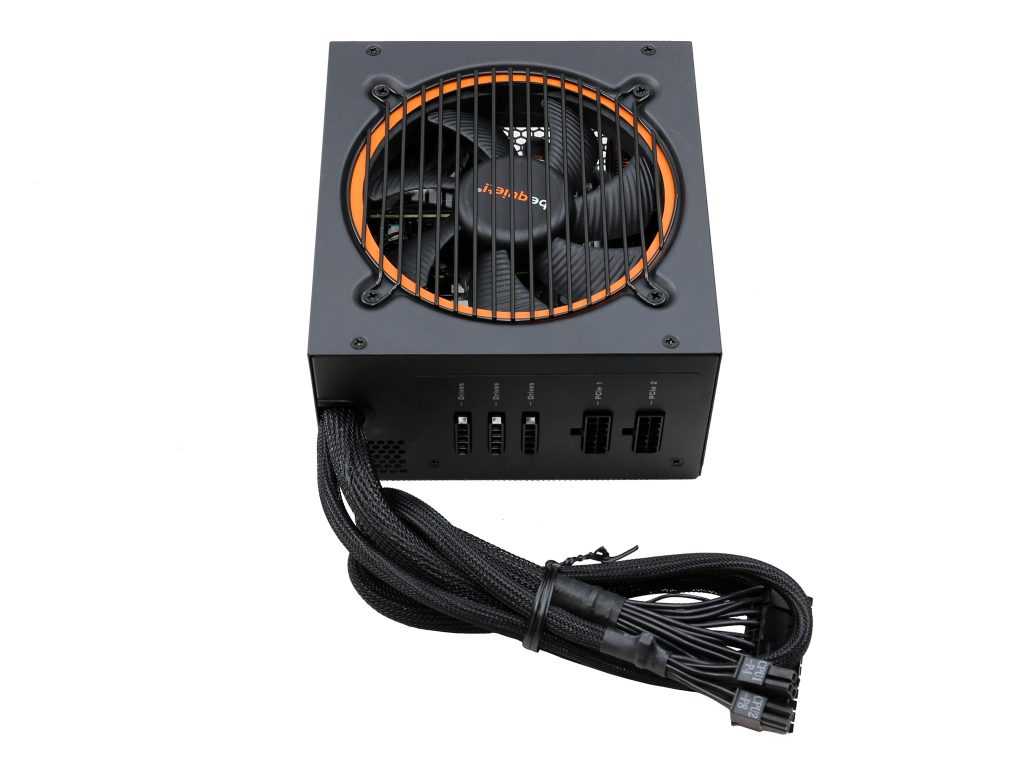 I can’t take my eyes off the speakers, which silently leave the dashboard in front of the A-pillars, as soon as I press the luxurious engine button on the center console, as if carved from warm crystal. I admire the door handles, filled from the inside with gentle unobtrusive lighting — not very comfortable, but how good! Yes, yes, I like her flaws too! No glove box, sun visor lights, door closers and all-wheel drive? Well, that’s right — this is a girl’s car for you, or what? Are you struggling to adjust mirrors? Think! But these are not mirrors at all, but real works of engineering art: mounted on elegant long bladed legs, they are so carefully designed aerodynamically that they direct the air flow just into the air ducts in the rear pillars. And how nice it is to look into these mirrors — in addition to the actual picture, they reflect the mighty hips of the rear wings of the DB11.
I can’t take my eyes off the speakers, which silently leave the dashboard in front of the A-pillars, as soon as I press the luxurious engine button on the center console, as if carved from warm crystal. I admire the door handles, filled from the inside with gentle unobtrusive lighting — not very comfortable, but how good! Yes, yes, I like her flaws too! No glove box, sun visor lights, door closers and all-wheel drive? Well, that’s right — this is a girl’s car for you, or what? Are you struggling to adjust mirrors? Think! But these are not mirrors at all, but real works of engineering art: mounted on elegant long bladed legs, they are so carefully designed aerodynamically that they direct the air flow just into the air ducts in the rear pillars. And how nice it is to look into these mirrors — in addition to the actual picture, they reflect the mighty hips of the rear wings of the DB11.
To Russia with love
Last year, 20 Aston Martins were sold in our country, in the future they plan to sell ten DB11s — the delivery time will be 4 months. In Russia, the first cars will appear in May, while for the rest of the world the start took place at the end of October. The delay is due to difficulties with homologation, and it’s not about ERA-Glonass, it’s just that you need to send three cars for crash tests, 15 million each! The first art studio in Europe, Laboratory Q, is already operating in Moscow, where you can order a completely unique Aston Martin, and a new boutique of used cars has opened on Petrovka for Christmas.
In Russia, the first cars will appear in May, while for the rest of the world the start took place at the end of October. The delay is due to difficulties with homologation, and it’s not about ERA-Glonass, it’s just that you need to send three cars for crash tests, 15 million each! The first art studio in Europe, Laboratory Q, is already operating in Moscow, where you can order a completely unique Aston Martin, and a new boutique of used cars has opened on Petrovka for Christmas.
I agree, maybe I’m a bit overzealous. Surely, the aura of the British brand soaked up by a virginally pure boyish brain decades ago acts on me — it’s really legendary, behind which a long train of the most incredible stories stretches, racing, cinematic, spy, love. And now, like the hero of Neil Simon’s tragicomedy, I suddenly discovered that in my old age I did not do anything heroic or crazy, I never got into a fight, like a real man should, I never cheated on my wife … And I’m ready! Where are these six hundred forces of yours? Submit here!
Space, freedom, cleanliness
However, even if you slightly reduce the intensity of enthusiasm and try to look at the new English supercar in a more balanced way, you will first of all find advantages, and by no means disadvantages. For the purity of the experiment, I enlisted the support of Nikita Rozanov, professor of the famous Stroganov. And it turned out that the head of the transport design department fully shares my feelings. He only states them more precisely and more professionally: “Look how carefully everything is thought out: the door opens, and cleverly placed lamps flood the entire interior of the car with soft light, making it incomparably larger than what you would expect to see in a 2-door coupe.”
For the purity of the experiment, I enlisted the support of Nikita Rozanov, professor of the famous Stroganov. And it turned out that the head of the transport design department fully shares my feelings. He only states them more precisely and more professionally: “Look how carefully everything is thought out: the door opens, and cleverly placed lamps flood the entire interior of the car with soft light, making it incomparably larger than what you would expect to see in a 2-door coupe.”
Marek Reichman
Creative and fun
was born in 1966 in Sheffield to an English mother and a Polish immigrant. Noticing his son’s penchant for drawing, his father sent him to study at Newcastle College. Marek graduated with honors from the Department of Industrial Design at the University of Middlesbrough and studied at the Royal College of Art in London. Then he worked at Land Rover, where he created a fundamentally new 2003 Range Rover, was the chief designer of the California studio of BMW, and then of Ford. He has such cars as Rolls-Royce Phantom, Lincoln MKX and Navicross Concept. For the past 11 years, Marek has been head of the Aston Martin Design Bureau. According to Reichman, the work is very creative and fun. In a small company with 1,400 employees and only 23 in the design department, decisions are made very quickly, but this also makes you constantly be in good shape and think about the company’s plans, according to which every 3-4 months designers need to start developing a new model. Reichman most often draws inspiration for new works from architecture and art — for example, he adores the work of British architect Zaha Hadid. For Aston Martin, Marek created Rapide, DBS, Vanquish, V12 Vantage, Rapide S, Vantage S, One-77, Zagato and DB11. Aston Martin’s chief designer has been driving since childhood and would love to take part in races, but, unfortunately, the designer’s two-meter height is not compatible with motorsport.
He has such cars as Rolls-Royce Phantom, Lincoln MKX and Navicross Concept. For the past 11 years, Marek has been head of the Aston Martin Design Bureau. According to Reichman, the work is very creative and fun. In a small company with 1,400 employees and only 23 in the design department, decisions are made very quickly, but this also makes you constantly be in good shape and think about the company’s plans, according to which every 3-4 months designers need to start developing a new model. Reichman most often draws inspiration for new works from architecture and art — for example, he adores the work of British architect Zaha Hadid. For Aston Martin, Marek created Rapide, DBS, Vanquish, V12 Vantage, Rapide S, Vantage S, One-77, Zagato and DB11. Aston Martin’s chief designer has been driving since childhood and would love to take part in races, but, unfortunately, the designer’s two-meter height is not compatible with motorsport.
Of course, you should not think that four people can travel in a car interior built according to the 2 + 2 scheme. I tried — from Leninsky Prospekt to Sparrow Hills, a large man 185 cm tall can, of course, drive in the back seat of a DB11, but not further, otherwise his legs will fall off. And yet, the most powerful feeling from the interior of the Aston Martin is the comfort and spaciousness unusual for a supercar. “Assessing the interior space of a car in such slushy and cold weather is a simple and beneficial thing,” Nikita Evgenievich smiles. — Finding himself under any roof, a person will fall under the enchanting influence of warmth and comfort. But Aston Martin is not designed for these sensations, it was created for exorbitant speeds and sportsmanship. Meanwhile, for starters, riders are simply drowning in the hospitality of the seats, finished in exquisite leather with a texture of natural wrinkles and folds, characteristic of freely flowing strips of leather. Rich lighting gives the interior a feeling of spaciousness unusual for such machines. In general, it is this feeling of spaciousness, freedom and cleanliness that distinguishes the DB11 from all its predecessors and competitors.
I tried — from Leninsky Prospekt to Sparrow Hills, a large man 185 cm tall can, of course, drive in the back seat of a DB11, but not further, otherwise his legs will fall off. And yet, the most powerful feeling from the interior of the Aston Martin is the comfort and spaciousness unusual for a supercar. “Assessing the interior space of a car in such slushy and cold weather is a simple and beneficial thing,” Nikita Evgenievich smiles. — Finding himself under any roof, a person will fall under the enchanting influence of warmth and comfort. But Aston Martin is not designed for these sensations, it was created for exorbitant speeds and sportsmanship. Meanwhile, for starters, riders are simply drowning in the hospitality of the seats, finished in exquisite leather with a texture of natural wrinkles and folds, characteristic of freely flowing strips of leather. Rich lighting gives the interior a feeling of spaciousness unusual for such machines. In general, it is this feeling of spaciousness, freedom and cleanliness that distinguishes the DB11 from all its predecessors and competitors. ”
”
It is curious that the English designers set themselves just such a task. “We weren’t looking to replicate the sharp, edgy, often hypertrophied edges of today’s ultra-fast supercars,” said Aston Martin’s development director Ian Meinards. “And they tried to embody in our car the spirit of true sports driving and, above all, unsurpassed beauty.”
It turned out to be extremely convincing. “Surprisingly, there is no hint of the overwhelming hegemony of roughly polished metal or the texture of brutally protruding carbon fiber fibers in which other modern supercars bathe in the finish,” Rozanov praised his English colleagues with pleasure. — For example, even Bang & Olufsen, known for its technocratic style, which was entrusted with the musical accompaniment of a trip to the DB11, accepts the rules of the game proposed by the designers and conquers with an unprecedented elegance of decoration. One touch, and here it is — the famous soundtrack to the film «Golden Eye» sounds:
…Our Love is Just like James Bond
I live my High life, Drive in My Cars,
Our Love is Just like James Bond…”
We will do everything ourselves
One touch.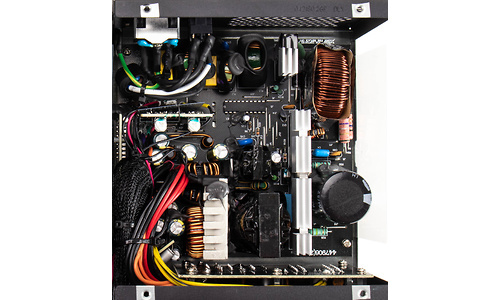 .. Exactly! Why, even the most ordinary selector of the 8-band «automatic» ZF, the British managed to make it completely special: the modes are switched not by a flimsy steering column lever, as in a Mercedes-Benz, not with a round washer, as in a Jaguar, but with buttons, as in American » road battleships» of the 50s. Speaking of Mercedes, the joystick of the multimedia system familiar from the S-Classe betrays its German origin. However, that’s all — the rest was designed by English engineers and made by English craftsmen at a new factory in Gaydon. In full accordance with the spirit of this small but proud company, they have always strived to go their own way, no matter what it costs in the most direct sense. That is why they tried to draw this joystick in their own way, wrapping it in the most delicate skin, and even the suppliers made LED headlights and Bridgestone tires by special order of Heydon originals especially for DB11.
.. Exactly! Why, even the most ordinary selector of the 8-band «automatic» ZF, the British managed to make it completely special: the modes are switched not by a flimsy steering column lever, as in a Mercedes-Benz, not with a round washer, as in a Jaguar, but with buttons, as in American » road battleships» of the 50s. Speaking of Mercedes, the joystick of the multimedia system familiar from the S-Classe betrays its German origin. However, that’s all — the rest was designed by English engineers and made by English craftsmen at a new factory in Gaydon. In full accordance with the spirit of this small but proud company, they have always strived to go their own way, no matter what it costs in the most direct sense. That is why they tried to draw this joystick in their own way, wrapping it in the most delicate skin, and even the suppliers made LED headlights and Bridgestone tires by special order of Heydon originals especially for DB11.
The philosophy of Aston Martin is expressed in three words: strength, beauty and soul
And this means, first of all, that the 11th is not a modernization of the «nine», not an evolution of any of the previous models, but a completely new car designed from scratch. At the heart of the machine is an aluminum spatial truss weighing only 240 kg. Body panels made of the same winged metal are hung on it. Moreover, some of them are completely unique, such as, for example, the hood — the largest aluminum part in the automotive industry. The technologists had to work hard to find suppliers of a sheet of such a width and stamps of such a size, but in the end (not the first, not the second, not even the third time!) They solved the task set by the designers.
At the heart of the machine is an aluminum spatial truss weighing only 240 kg. Body panels made of the same winged metal are hung on it. Moreover, some of them are completely unique, such as, for example, the hood — the largest aluminum part in the automotive industry. The technologists had to work hard to find suppliers of a sheet of such a width and stamps of such a size, but in the end (not the first, not the second, not even the third time!) They solved the task set by the designers.
A whim, you say? Not at all. Aesthetic perfection — of course, as far as it is generally possible in our imperfect world — is combined in this machine with technical and engineering perfection. Suffice it to mention the aerodynamics of the body, in sophistication approaching the abstruse designs of Formula 1. Chief designer Marek Reichman didn’t want the DB11’s rear wing to be spoiled by the «duck tail» of the wing, as on all other supercars. And then Gaydon came up with a “virtual spoiler”, directing streams around the body along the sidewalls from the mirrors to the rear pillars inside the trunk lid and forcing the air to work as the working surface of the spoiler.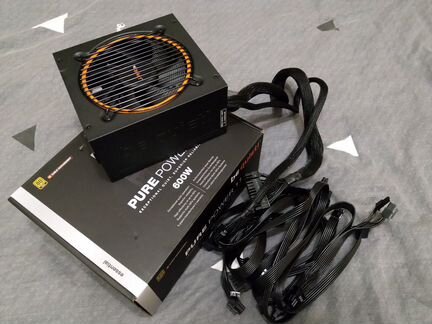 And only at speeds above 112 km / h a small (only 45 mm in height) anti-wing extends from the body, increasing the downforce imperceptibly to the aesthete’s eye.
And only at speeds above 112 km / h a small (only 45 mm in height) anti-wing extends from the body, increasing the downforce imperceptibly to the aesthete’s eye.
Nikita Rozanov
Professor, Head of the Department of Design of Means of Transport, Moscow State Art Academy named after. S.G. Stroganov
OVERCUT
We can say that the shape of the car is the embodiment of the company’s philosophy, which is expressed by three words: «strength, beauty and soul.» These three concepts are most easily translated into the language of style and design. And if earlier it was only possible to suspect that Aston Martin managers, in addition to striving for high speeds and reducing the weight of the car, have deep interests in style and design, then after a close acquaintance with the DB-11, there is no trace of the previous suspicions — they are replaced by firm confidence in the inseparability of brand links with beauty and usefulness.
Throughout its long life, the company has been in relentless competition with brands such as Bentley and Ferrari. At the same time, Aston Martin is always on its own. He did not have rich patrons, so often designers had to modernize the style of the legendary predecessors. As a result, there were not many new ideas in terms of style. Taking advantage of this, Bentley and Ferrari went into the gap.
Everything started to change after Marek Reichman became chief designer 6 years ago. As a result, the DB11 has acquired breathtaking shapes and lines, including a large number of original solutions, based on the historical heritage of the brand and an innovative approach to aerodynamics. Compared to its predecessor, the car is not only wider, but also longer, which has a positive effect on proportions, ease of entry/exit and placement of the driver and passenger in the cabin. The model received a number of major styling updates, while maintaining the style of family traits and the spirit of the brand.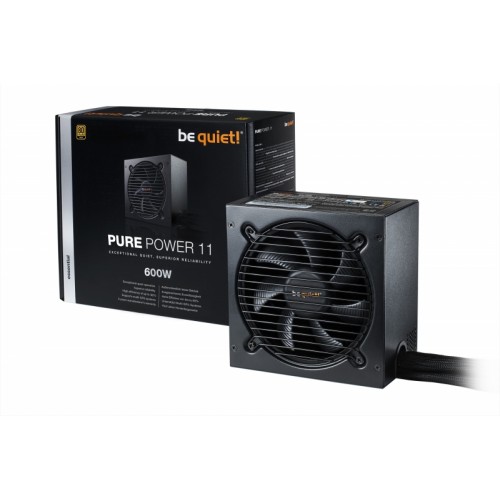 This is so obvious that at first glance, the novelty may seem indistinguishable from Vanquish. In fact, the DB11 is a completely different car with a fundamentally different aerodynamic scheme, different plastics and shape.
This is so obvious that at first glance, the novelty may seem indistinguishable from Vanquish. In fact, the DB11 is a completely different car with a fundamentally different aerodynamic scheme, different plastics and shape.
Eye-catching long and beautiful aluminum hood, completely new LED lighting technology. Naturally, the well-known outline of the historical radiator grille, which was complemented by expressive silver strips, is intact and intact. The shape of the rear fenders has changed significantly and the slope of the rear window has increased, which most significantly corrected the overall silhouette of the car, built according to the classic canons of the Cab Reverse layout.
In general, the impression is as follows: the rushing whirlwinds of air currents, falling into the hands of designers, miraculously become endowed with the function of a chisel of a sculptor-genius, cutting off everything superfluous and insignificant from a block of marble.
It is worth taking a closer look at the design of the DB11, and it turns out that all of it seems to be woven from such mini-masterpieces. Not noticeable and not so important, as if, at first glance, together they solve the very problem of combining technical and aesthetic perfection. To achieve the sense of spaciousness that struck us, Aston Martin’s designers have increased the coupé’s base by 52 mm compared to the DB9, trying to maintain the dimensions of the car. And in order to instill in her a polished branded handling, Gaydon hired an extra-class specialist — Matt Becker taught the sport-racing Lotus for 26 years and now designed the DB11 suspension. Surprisingly, the British abandoned their beloved hydraulics by installing electric power steering. Meanwhile, it was precisely the subtle feeling of the steering wheel inherent in all Aston-Martins that was especially appreciated before by connoisseurs. “I’m willing to bet,” says Maynards. “That no one will regret this decision. One of the advantages of our small firm is that although we are not always the first to apply some technical innovation, we have the opportunity to bring it to perfection.
Not noticeable and not so important, as if, at first glance, together they solve the very problem of combining technical and aesthetic perfection. To achieve the sense of spaciousness that struck us, Aston Martin’s designers have increased the coupé’s base by 52 mm compared to the DB9, trying to maintain the dimensions of the car. And in order to instill in her a polished branded handling, Gaydon hired an extra-class specialist — Matt Becker taught the sport-racing Lotus for 26 years and now designed the DB11 suspension. Surprisingly, the British abandoned their beloved hydraulics by installing electric power steering. Meanwhile, it was precisely the subtle feeling of the steering wheel inherent in all Aston-Martins that was especially appreciated before by connoisseurs. “I’m willing to bet,” says Maynards. “That no one will regret this decision. One of the advantages of our small firm is that although we are not always the first to apply some technical innovation, we have the opportunity to bring it to perfection.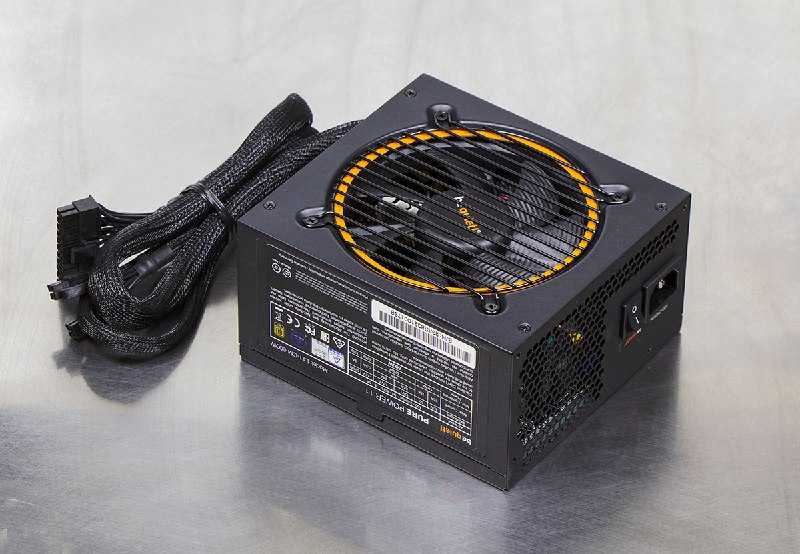 Our electric power steering wasn’t the first, but it will be the best.»
Our electric power steering wasn’t the first, but it will be the best.»
Affectionate Beast
So turbocharging has never before defiled an Aston Martin. Many cylinders, large displacement — this has been the formula for the success of this purely British breed of engines for many decades. And yet, obviously, there comes a moment when loyalty to traditions begins to turn into causeless stubbornness. Perhaps better than anyone at Gaydon, the new boss, Andy Palmer, who until October 2014 served as chief executive of Nissan, where he was responsible for global planning, understood this. However, work on a new engine began even before his arrival. And true to their creed, English engineers designed the motor from scratch.
“No, we didn’t upgrade the 5.9-liter naturally aspirated V12,” says Meinards. “And this is not at all the result of joint development with Daimler engineers. This is our engine, conceived and designed in the UK.” The engine still has a dozen cylinders and an impressive 5. 2 liters, but twin turbos, a start/stop system and half-cylinder shutdown at partial loads make this unit quite competitive in terms of fuel economy and emissions. Moreover, the British took special care to preserve the authenticity of the breed to the maximum.
2 liters, but twin turbos, a start/stop system and half-cylinder shutdown at partial loads make this unit quite competitive in terms of fuel economy and emissions. Moreover, the British took special care to preserve the authenticity of the breed to the maximum.
The fact is that two small turbines in the exhaust system deprive the voice of the Aston Martin — the very hoarse, on the verge of howling roar that for many years delighted the ears of connoisseurs of the British brand — most of the high frequencies. In Gaydon, they did a lot of conjuring over the geometry of the exhaust system in order to reduce “voice loss” to a minimum. Yes, the DB11 growls more bass than its predecessor, but this is inevitable — after all, the machine of a new generation, a new era.
“DB11 is our most beautiful production model, and in terms of proportions, our best car in general”
To understand this, it turned out to be enough on a cold and gloomy winter day (a weekday, moreover) to go to the streets of Moscow. How can you drive a 608-horsepower supercar through metropolitan traffic jams? Easily! An unexpectedly comfortable beast, unusually adapted to daily use, turned out to be the work of English craftsmen. On speed bumps, the suspension, designed for exorbitant cornering speeds, behaved surprisingly friendly, in the slippery winter slush, which, as if on purpose, the heavenly office had spoiled Moscow, the heavy-duty rear-wheel drive car behaved extremely reliably and predictably. The British engineers abandoned the 4×4 transmission for fundamental reasons — a sports car does not need it, according to Gaydon. But despite this, the main plus of Aston Martin is that the car does not bother you at all, you can safely drive around the city every day on the DB11. And at the same time, as soon as such an opportunity presented itself, I pressed on the gas, and 608 forces instantly blew the rear wheels into a slip, and in a moment a powerful, tight, lively wave of acceleration pressed me into a stitched leather chair .
How can you drive a 608-horsepower supercar through metropolitan traffic jams? Easily! An unexpectedly comfortable beast, unusually adapted to daily use, turned out to be the work of English craftsmen. On speed bumps, the suspension, designed for exorbitant cornering speeds, behaved surprisingly friendly, in the slippery winter slush, which, as if on purpose, the heavenly office had spoiled Moscow, the heavy-duty rear-wheel drive car behaved extremely reliably and predictably. The British engineers abandoned the 4×4 transmission for fundamental reasons — a sports car does not need it, according to Gaydon. But despite this, the main plus of Aston Martin is that the car does not bother you at all, you can safely drive around the city every day on the DB11. And at the same time, as soon as such an opportunity presented itself, I pressed on the gas, and 608 forces instantly blew the rear wheels into a slip, and in a moment a powerful, tight, lively wave of acceleration pressed me into a stitched leather chair . .. Kaif!
.. Kaif!
By evening, parting with my affectionate beast, quietly purring half of the cylinders, I was one hundred percent sure that in our family there would be no question of buying diamonds, even if they decided to award me the Nobel Peace Prize. How can you compare a small transparent stone of four carats, that is, in truth, less than a gram, and this generator of pure pleasure called DB11? That’s it! And they cost, by the way, the same — 15 million.
Alexey Vasiliev
Professional race car driver, master of sports of international class, multiple champion of Russia
«Aston Martin» can only be like that!
I dive into this sports cockpit as if into some kind of capsule, which was created by designers especially for me. I am clamped on all sides by a console, and the seat itself is like a deep bowl, and a door with a recess for hands. In a racing car, I always have the safety cage removed so that nothing around the steering wheel interferes with the work of my hands. At Aston, everything is identical to racing ideas, and this gives me a feeling of complete safety.
At Aston, everything is identical to racing ideas, and this gives me a feeling of complete safety.
A very strong tilt of the steering column helps me not to pull the steering wheel, but to turn it with my whole body. In fact, I have unbending hands, but at the same time, my shoulders and everything else can participate in the management process. This adds significant clarity in guessing the trajectory and in finding the desired line. The brakes are mega-efficient — they are able to stop an electric train with the same intensity as a car. Nice feeling.
The engine is very quiet — unlike other supercars. Standing on the street next to the DB11, you hear a very active exhaust, and from under the hood you can only hear the slight rustle of fuel injectors, which does not give out a supercar in this engine, but only adds to the sexuality of the engine. The exhaust is set up in a very interesting way: when you switch the box mode, the exhaust sound changes. Or it is the motor settings that give a phase shift, and you have wider phases in the gas distribution system. As a result, both the power is higher and the exhaust becomes brighter, harsher and louder — more sporty.
As a result, both the power is higher and the exhaust becomes brighter, harsher and louder — more sporty.
The gearbox is completely flexible. Even, say, a Ferrari with the same dual clutch still has a delay. And the Mercedes SLS also has a delay. Moreover, the DB11 has in common with the SLS layout: the engine is in front, and the gearbox is in the back, on the bridge. But in the Aston, the gearbox really shifts very softly, elastically even in the mode of active driving at full throttle. The clutch actuation algorithm is very well configured: there is no peck. At the moment of gear shifting, you absolutely do not feel longitudinal rocking either up or down.
And of course, I think that the V12 under the hood of a supercar is much more correct than some V6 with two turbines, where you have half the engine compartment of the void: you carry air. For the same amount of power, the V12 delivers high torque at low revs, makes the car very comfortable for everyday use, and still has a lot of power that you can use on track days.
Aston Martin must be a supercar. If a Ferrari is a gift for a girl, for a mother, for a son, then the Aston Martin can only be like that.
Vasiliev drove an Aston Martin in the GT World Championship: “The DB9, prepared in 2005 by Prodrive, was all carbon fiber and cost £1 million. He had colossal problems with the brakes and the engine. The next acquaintance took place in 2011: I drove a DB9 in the GT1 World Championship. And for 6 years nothing has changed: the same problems with the engine and intake manifold.
I’m used to seeing the road, and the layout of the DB11 makes me see the horizon. For a track day, I would not choose this car because I will not see the apex and dangerous places on the track. I can see distant aiming points at the end of the straight, but in reality, for active work in corners, I simply will not see the track. That is, I have to drive on a circuit that I know by heart, because the close view is eaten in the DB11: I don’t see the nearest obstacles and landmarks. ”
”
Seal
| Type | V12 turbocharged, 4 valves per cylinder | |
|---|---|---|
| Location | front longitudinal | |
| Displacement, cm3 | 5204 | |
| Power, hp / rpm | 608/6500 | |
| Torque, Nm/rev./min. | 700/1500-5000 |
| Drive unit | on the rear wheels | |
|---|---|---|
| Transmission | 8-speed automatic |
| Length/width/height, mm | 4739/1940/1279 | |
|---|---|---|
| Wheel base, mm | 2805 | |
| Curb weight, kg | 1770 | |
| Volume, tank, l | 78 | |
| Tire size front-rear | 255/40ZR20 — 295/35ZR20 |
| Speed, km/h | 322 | |
|---|---|---|
| Acceleration 0-100 km/h, s |
3.
|
